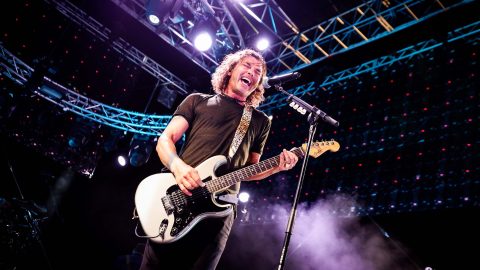
A week before Paris went into lockdown, French writer and director Céline Sciamma was just starting to sketch out the beginnings of her next project after the breathtaking Portrait of a Lady on Fire (which NME gave five stars). Petite Maman – out today (November 19) – opens on a care home, with eight-year-old Nelly saying goodbye to each resident one by one. Though originally a coincidence, the scene’s newfound prescience pushed Sciamma to speed up the project, even amid strict restrictions around filming. “Do we wait for the big festivals to put us on their red carpets,” she asks today, “or do we rush in because cinema is a social responsibility?”
Since her 2007 debut Water Lillies, Sciamma’s films have delved into intense relationships that unfold in small, enclosed spaces over brief snatches of time – a feast of stolen glances, lingering touches, and fleeting details that slowly tumble together to take on greater significance. In Petite Maman, meanwhile, Nelly has a magical knack for time travel – but in place of blooping machines, the transportive power of memory creates a space for conversations that feel impossible in the present.
Over the course of a few days packing up her dead grandmother’s house, Nelly forms a touching friendship with her own mother as a child. As they build wooden houses and stage elaborate plays together, Nelly and Marion reveal their greatest fears, hopes and secrets to each other, uniquely reframing the parent-child dynamic in the process.
As the film hits cinemas, NME meets Sciamma to learn more.
In Petite Maman, Nelly time-travels so that she can speak to her own mother as a child. Do you think we all have that capacity in our imaginations?
“I do. There are a lot of unused capacities within us, and this film is designed to give us that power. Really, the idea of film is to put a little [time] machine in your heart and your head, and you can use it if you want. When you ask people: ‘If you had a time machine, what would you do?’ it’s always about tourism. They say, I would go to see Bastille Day, or to ancient Egypt. In a way, it’s a lack of imagination! Very few people say they would go and see their grandma, or lover, as a kid. I would do that for sure. People who have experienced great loss… those machines are in a lot of those people’s hearts.”
The opening scene of Petite Maman is shot in a care home – it feels very timely now, but when did you write it?
“A week before lockdown, before we even knew what was happening, I locked myself in (wrong decision) to write the first scenes of the film. I took it back to Paris, and didn’t open the script again for two months. When I opened it again, this very intimate scene had become charged with a new collective meaning. The film transformed because our world has shifted, and this scene particularly made me think: ‘Oh my god, this could be good for people in cinemas.’ That’s what made me rush into the film.”

The last 18 months have been particularly hard for young kids – were you thinking about them when you made the film?
“I was thinking about how kids were feeling, but also how they were being treated. Kids are always portrayed as citizens of the future, but they are also citizens of today. They’re always instrumentalised – everything’s about ‘protecting the kids’ but we’ve seen that isn’t true. If we look at why they’re scared, there’s this global disease that can infect people that you love but you’ve still got to go to school.
“In France, the schools closed for only two months. I’m not saying it’s bad, I’m just putting myself in their shoes. Kids in France have known big terrorist attacks, #MeToo… they talk about it, they hear the news, and they’re not given any political weight even though they are the leaders of the fight that matters today: climate change. They’re not heard or considered as full individuals, and the film is also advocating for that. I don’t know how it was here [in the UK] but I know that in New Zealand there was a press conference only for kids saying: ‘Here’s what’s happening.’ We keep pretending they don’t hear the news, but they’re just beside you listening to Boris Johnson.”
How was it working with twins Joséphine and Gabrielle Sanz – the child actors who play Nelly and Marion?
“It has been a very joyful collaboration. They were a duo, and it was really nice to work with two people who really trust each other. It’s beautiful to watch a kid grow and learn cinema, and there’s something beautiful about really looking at somebody who’s changing one day after another. It’s super moving.“

You can really see that connection – when they were making pancakes together, I wanted to join in. Their laughter was that infectious…
“The little munchkins. It was the easiest [scene to film] and really simple – just two takes. It’s the only improvised scene, though there’s a recipe, so it’s not that improvised. Those laughs are quite unique. In Portrait of A Lady on Fire, there’s such good chemistry between the actors [Adèle Haenel and Noémie Merlant] and I was like: ‘They’ve got to smile at the bonfire [scene] at some point. I don’t want it to just be: Oh, they look so beautiful.’ It’s the same working with kids – when there’s laughter, you will want to join them.”
Portrait of a Lady on Fire came at a time when many other filmmakers seemed to be making period lesbian dramas. Why are historical settings so popular in queer storytelling right now?
“Well, I don’t know if I have any thoughts about how there’s a fashion there. We can see it as a way of rewriting stories, but we could also see it as a way of not being brave at all about our contemporary stories. The stories from our past should be more collective if we are trying to write the missing story – it should be about community and political ideas. That’s what I tried to do with Portrait… I really try to connect it to today, and I’m not sure that all films do that. I think sometimes just looking at a story from the past’s perspective is just really a way to say: ‘Oh, today’s fine.’ It’s not true, it’s really not.”

Many of your films seem to be interested in the idea of time running out – in Petite Maman, for example, Nelly and Marion only have a few days together – why is that?
“When you are writing a script, you are carving through time, and it’s true that my films always look at a few days in the life of somebody. For me, cinema has much more to do with music than literature: it’s really about rhythm and time. I think the only conflict that still remains in my film is time: the time we have. My next project, the one I’ve really started thinking about, is all based on time.”
Tell us more about your new project…
“I could tell you it might not be in French…”
‘Petite Maman’ is in cinemas now
The post Céline Sciamma: “Kids aren’t given political weight but they are leading the fight against climate change” appeared first on NME.








